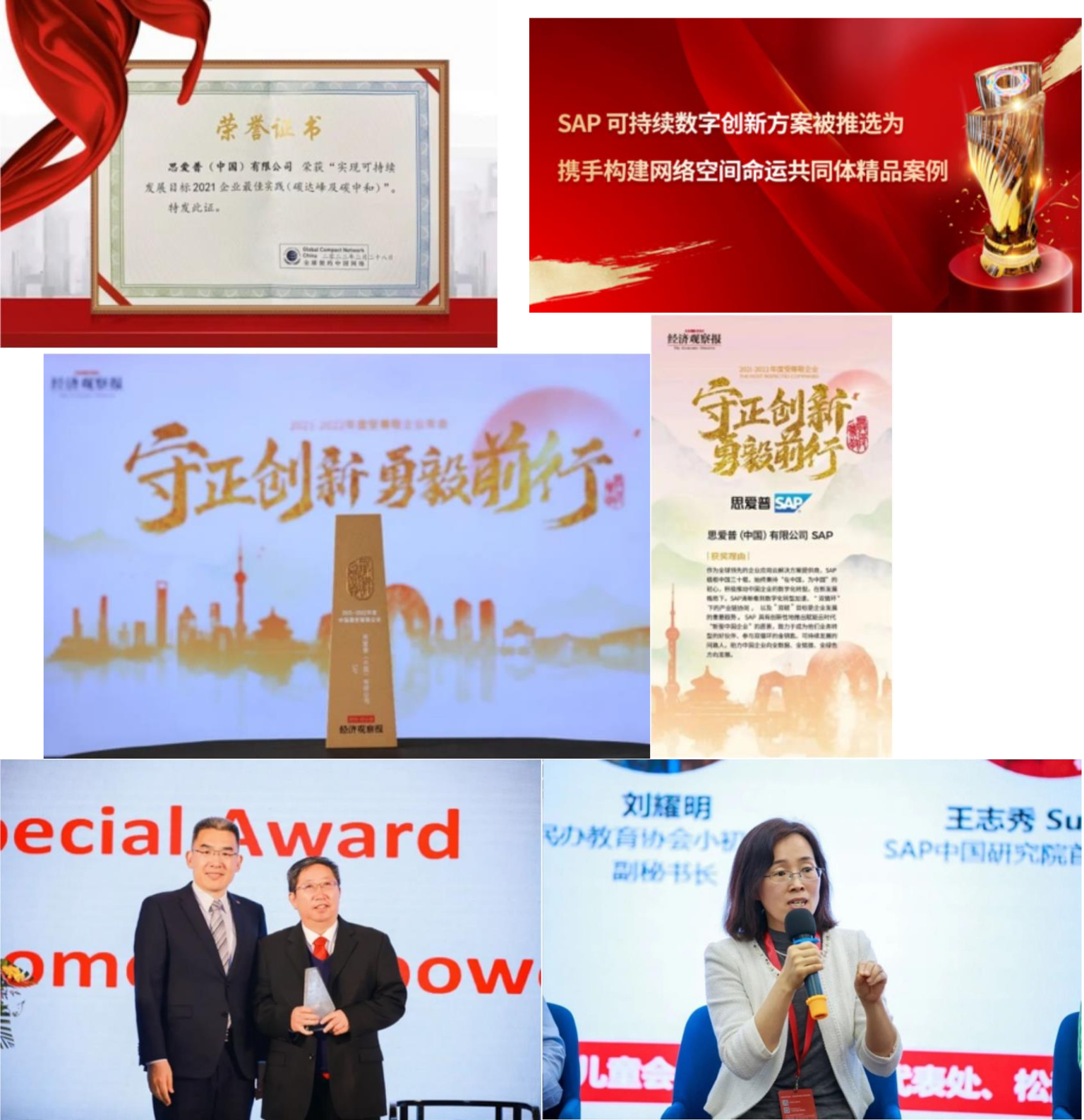Company Name: SAP Labs China
Award Category: ESG Performance
Company Size: Large Business Group
Environment
Climate Change:
Goals:
Achieve carbon neutrality by 2023; achieve zero carbon emissions by 2030.
By 2025, electric vehicles account for 33%; by 2030 account for 100%.
Strive towards zero electronic waste by 2030
All SAP-owned facilities ISO 14001 certified by 2025
Path:
Zero waste: Gradually phasing out single-use plasVcs.
ConVnue to maintain low levels of electricity consumption in the office.
Properly manage and recycle our discarded electronic and electrical equipment.
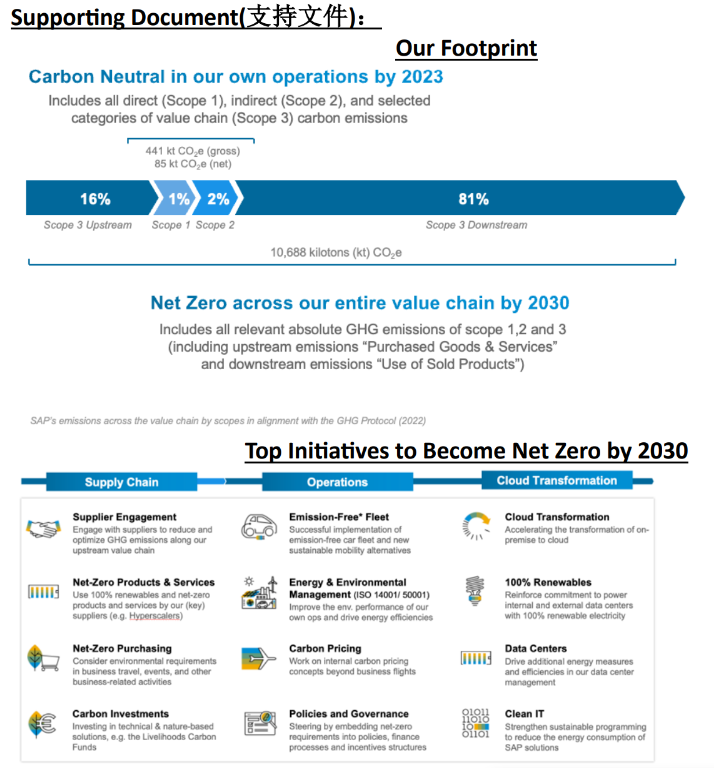
In Summary:
To ensure we reach our carbon neutrality commitment by 2023,SAP will contnue and expand existing initiatives and programs to drive efficiency and innovation, following our strategic approach to first avoid, secondly reduce.
Natural Resources and Energy:
Our company is fully embracing and supporting China dual-carbon goals and SAP global sustainability strategy.
This is the practice of resource consumption:
Water:
Use of water-saving fixtures to minimize water consumption.
Material:
Materials with high recycled content (carpets, acoustic panels, gypsum board, furniture etc.)
Low-emijng materials (flooring, paints etc)
Daily recycling areas in pantry areas
SAP is using Low-E glass, also known as low-emissivity glass, is a type of glass that is coated with multiple layers of metal or other compound films on its surface. The coating layers possess characteristics of high visible light transmission and high reflectance for mid to far-infrared radiation. This gives low-E glass exceptional heat insulation properties and excellent transparency, setting it apart from regular glass and traditional architectural coated glass.
HVAC System(Heat, Ventilation Air, and Cooling):
Separate thermal zoning control
Enough outdoor air provision meeting GB standard
Select high efficiency VRV system to save energy
Energy Recovery Ventilation
Lighting:
Scene control in boardroom
High performance glass curtain
Glass partition allows more daylight for interior space
Timer control in all open office with manual delay switch
LED lights are installed in all space to lower lighting power density
Access to daylight
Glare control

Prevention of Pollution:
As a staunch advocate and implementer of sustainable development concepts, SAP strictly adheres to ISO 9001, 14001, 18001, and 27001 standards in the disposal of IT equipment. We have entered into an equipment disposal contract with SIMS, a global equipment processing vendor. Our professional supplier, SIMS, provides us with specialized services, and together, SAP and SIMS rigorously adhere to these international standards during the electronic equipment disposal process, conducting regular checks on compliance.
As a responsible multinational IT technology company, SAP employs primary environmentally friendly approaches in China, including material separation, material recycling, and resale. These approaches aim to minimize environmentally polluting disposal methods such as incineration and landfill.
Material Separation:
IT equipment is assembled from various components. Suppliers dismantle nonfunctional devices, test functional parts for recycling, and classify them for reuse in assembling and repairing new devices. This reduces the production of such electronic components and lessens environmental pollution.
Material Recycling:
IT equipment contains several crucial rare metals, organic substances, and other valuable materials such as copper, iron, aluminum, and zinc. These materials possess high secondary use value, making their recycling vital for environmental conservation. Recycling these valuable metals not only reduces the demand for natural resources but also lessens environmental pollution and the impact of mineral extraction on the environment.
Resale:
SAP, as a top-tier IT enterprise, strictly regulates the production and commercial use of IT equipment, including electronic equipment disposal. SAP's discarded electronic devices refer to those no longer meeting production and commercial usage requirements, rather than devices entirely non-functional. Consequently, our suppliers reclaim and resell these devices, extending the life of well-performing devices and reducing excessive electronic device production, minimizing environmental harm.
Taking the example of the first half of 2023, SAP China disposed of 4,641 units of IT electronic equipment. Among these, 68.8% underwent material separation and material recycling, while 25.2% were resold. In total, 94% of the devices underwent environmentally safe disposal.
Under the theme of IT equipment recycling and reuse, this discussion explores perspectives related to resource preservation, energy conservation, pollution reduction, and employment opportunities. The main strategies and approaches that IT equipment recycling should follow are outlined. IT equipment recycling aims to safeguard the environment, recover as many resources and secondary values as possible, and promote the development of environmental initiatives. Strengthening protection and regulatory efforts is necessary to foster the healthy development of the modern IT equipment recycling and reuse industry, realizing a bright future of "green, health, and environmental protection."
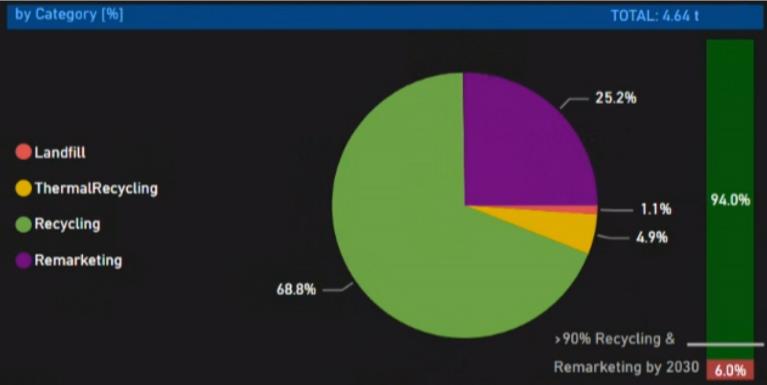
Other Actions Taken for Environmental Protection:
This year, on Earth Day 2023 (April 22nd), we officially launched the "Create • Act, One for More" employee sustainable development project in SAP Greater China. The project aims to encourage all colleagues to take collective action, embody the company's sustainable development goals, and contribute to establishing a world of zero emissions, zero waste, and equality, collaboratively shaping a prosperous and bright future.
SAP holds a Net Beach Cleanup event every year, putting the company's commitment to low-carbon environmental sustainability into action.
On August 27, 2022, the joint "Beach Cleaning" volunteer activity organized by SAP Dalian Corporate Social Responsibility and SAP Dalian Business Women's Network was successfully held at Heishi Reef Beach as scheduled. SAP volunteers, along with their relatives and friends, contributed to preserving the beautiful coastline. A total of 41 SAP volunteers contributed 176 hours of volunteer service time to this beach cleaning activity, ultimately collecting about 160 bags of beach litter (as shown in the figure below).
SAP organizes tree-planting activities every year. In 2023, a total of 2,384 employees from 14 offices across the SAP Greater China region took part, collectively walking 152 million steps. This effort resulted in a total carbon emission reduction of 11,151 Kg and fulfilled the commitment to donate and plant 30,519 trees. SAP has pledged to plant 5 million trees by 2025.
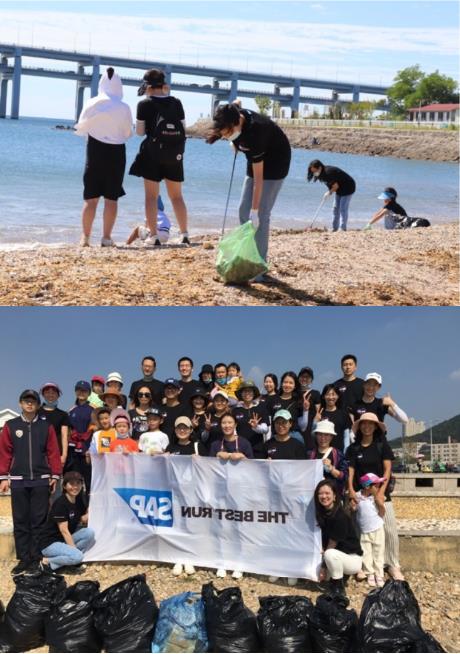
Social
HR Development and Engagement:
SAP has set a goal of 50 learning hours per employee per year. To reach this learning goals, employees can find career development resources, leadership learning journeys, and tailored learning content for their role and functions in the SAP Learning page on the website.
Establishing trust in leaders is crucial for continuously enhancing employee engagement. Our leadership trust is measured using the Net Promoter Score (NPS) method, within a range of -100 to +100. From the graph, we can see that in 2023, compared to the global score of 72, SAP Labs China scored 82, which is 10 points higher.
Retention rate for the third quarter of 2023 reached as high as 96.2%.
SAP offers a lot of benefits for employees:
Insurance: Free health screening; Group Insurance (Medical, Life and Accident); Business Travel Insurance
Work-Life Balance: Childbirth Allowance, Wedding gift, Supplementary Housing Allowance, Compassionate Allowance, Benevolent Money, Fitness Allowance.
We measure the progress of individual employee and organizational health through the Business Health Culture Index (BHCI). The data for SAP Labs China in 2023 far surpasses the data for SAP Global.
SAP Labs China has dedicated health ambassadors who consistently prioritize employee well-being, including mental health. The significance of employee mental health cannot! be overstated, and this is a vital aspect of their overall well-being and productivity. These health ambassadors play a crucial role in fostering a supportive and holistic work environment.
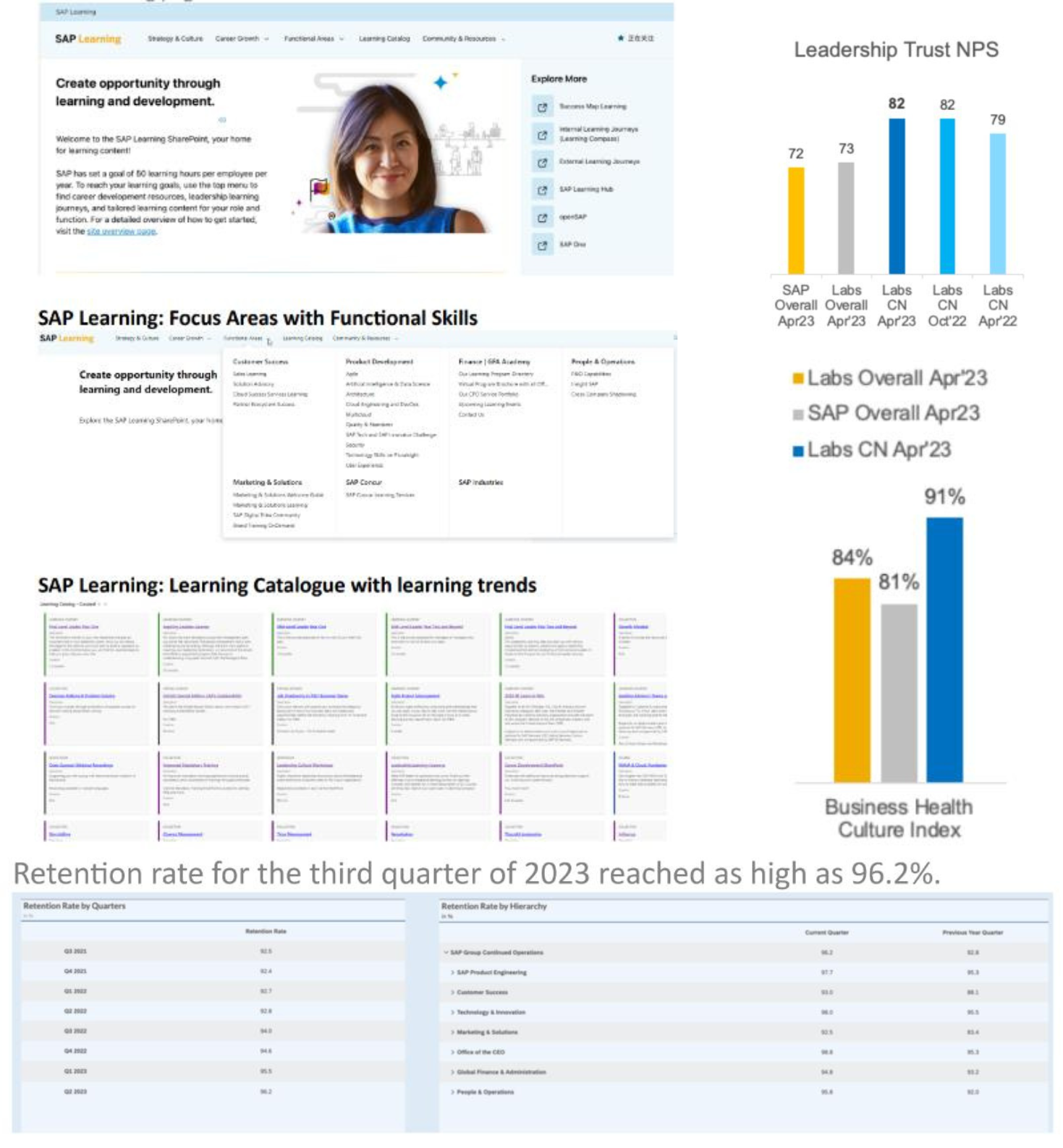
Diversity, Equity and Inclusion:
The proportion of women in the management team of the China Research Institute is 38.8%, with female employees accounting for as much as 39.8%.
SAP Autism at Work: 2022 is the 7th year for SAP Autism at Work program running in Greater China. We keep creating pathways that help people with autism to have a full and productive employment and work life. This is how we bring to life SAP vision in "Help the World Run Better and Improve People's Lives". In 2022, we will continue to build the diverse workforce through Autism at Work program and continue to nurture the ecosystem for a greater autism inclusion through 5 branch programme: SAP SCHOOL 4 Autism at Work, SAP YOUTH 4 Autism at Work, Autism Inclusion Pledge, Talent Market 4 Autism at Work and Support Circle 4 Autism at Work.
To be an intelligent enterprise, we need an inclusive culture that empowers all employees to achieve their best version. Pride@SAP has the commitment to represent the LGBTIQ+ community and ensure that SAP's offices have a diverse and respectful culture, where employees can be who they are without fearing any kind of prejudice.
In 2020, SAP launched the Girls Power Tech program in China to encourage financially disadvantaged girls from remote areas in the world's most populous countries, by providing internship opportunities in different line of business team and making technology accessible.

Product Liability:
SAP's corporate Quality Management System (QMS) consists of several QMSs, all aligned with SAP's corporate Quality Policy, Quality Strategy and Quality Goals and holistically defined through processes and guideline.
The SAP Development QMS covers the development of software business solutions. It aligns and orchestrates all development organizations to provide quality products and services to SAP's customers and ensures that SAP Corporate Requirements are fulfilled. Global guidance is given by the SAP Quality Strategy, SAP Quality Policy and SAP Development Policy, reflected in core processes of the QMS to facilitate an effective and efficient interaction of all units collaborating on products and services. SAP holds an ISO 9001 certificate for its Development QMS as proof of our commitment to quality and to fulfill the expectations of our customers. SAP's quality standards are globally applicable, including SAP labs. These quality standards require good practices, the control of documents, records and non-conforming products, continuous improvement of the QMS and senior management engagement.
Product Standards (PS) define software qualities which need to be fulfilled by all SAP products to enable SAP's business model. To do so, product standards define requirements to enable selling SAP products worldwide, efficient support, reaching all kinds of users, mitigating risk of lawsuits, up- and cross-selling into existing customer landscapes, and so on.
SAP has integrated Product Standards into the development process to achieve transparency about SAP products' qualities.
IP protection- Mandatory training - Avoiding Intellectual Property (IP) Risks is a mandatory compliance training on the Global IP Policy and the Global NDA/Confidentiality Policy. The training covers a set of behavioral rules that SAP employees must observe to comply with regulatory and legal requirements in the area of intellectual property law. The training aims to remind SAP employees of their understanding of the policies, their responsibilities, and their roles when accessing the intellectual property of SAP and third parties.
Regarding Customer Rights Protection: SAP provides regular software upgrades for free, enabling customers to continuously benefit from the latest product solutions. Additionally, SAP collects customer feedback through various channels, incorporating customer needs into standard product roadmaps to ensure products consistently align with customers' evolving business requirements. For instance, initiatives like Customer Connection. As part of SAP's Influencing channels, SAP Customer Connection and SAP Continuous Influence provide our Customers with a direct and transparent channel to address improvement requests related to SAP products and solutions in use, to SAP development teams, with the support of the User Groups and an active global user community. Participation in SAP Customer Connection (CC) and SAP Continuous Influence (CI) activities, as well as the use of resulting improvements, is free for all customers with valid maintenance.; Customer Engagement Initiative: SAP Customer Engagement Initiative (CEI) enables development teams to discuss planned standard functionality with customers and partners to gain valuable input during the development phase.
Supply Chain:
SAP's procurement philosophy centers on cost-effectiveness and quality, supplier selection is based on reliability, compliance, quality, competitiveness, and sustainability.
SAP integrates ecological practices and requirements into procurement, expecting suppliers to share this commitment throughout their supply chains. Environmental aspects are integral to purchase orders and contracts, reinforcing SAP's dedication to ecological best practices.
In supplier relationship management, a structured approach is taken, focusing on key suppliers' compliance, classification, performance evaluation, and development. in summary, SAP's procurement principles prioritize cost-effectivenessnd quality while adhering to ethical standards and global principles.
Community Engagement:
SAP has a CSR community and here's our strategy and programs:
Life@Labs China is a platform that helps employees keep mental & physical healthy and contributes to People Success in diversity, inclusion & health.
To build best people experience through a variety of club activities across all Labs China locations.
To unlock opportunities for employees to embrace diversity and showcase their talent.
To strengthen the mindset of cross-team cooperation, and to foster a supportive and inclusive environment.
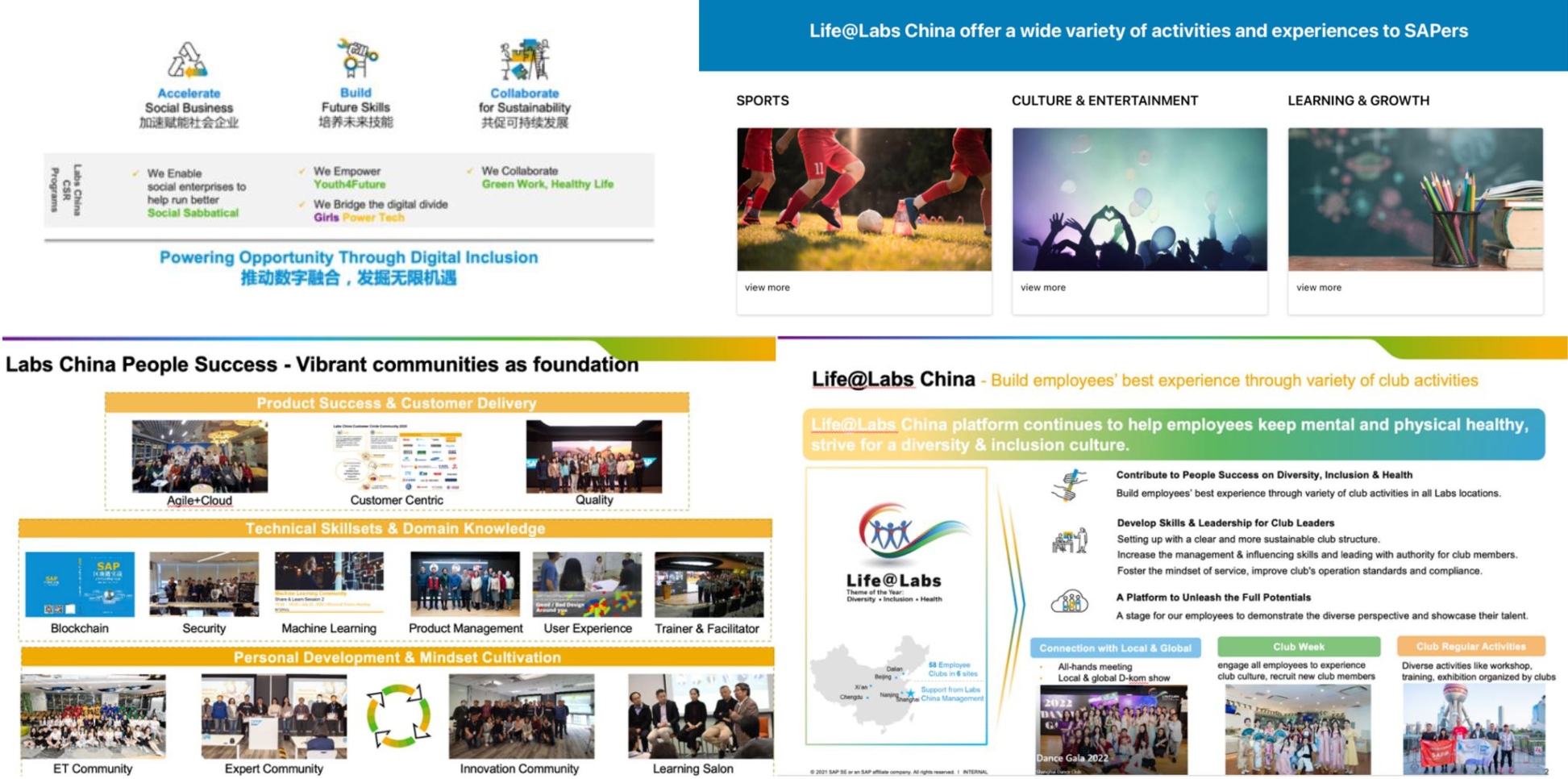
Corporate Governance
Governance Organizational and Mechanism:
SAP has a clear strategy and corresponding setup in the area of social responsibility.
For employee Diversity & Inclusion, there are regular senior leadership quarterly meetings involving participants such as the Greater China President, Labs managing director, diversity & inclusion champion, health ambassador, CS head, etc.
We conduct sustainability audits; wherein independent third-party organizations perform periodic comprehensive audits of SAP's global operations.
We provide annual training on the Code of Business Conduct for all employees.
We have internal training programs such as anticorruption and antibribery, conflicts of interest, governance for customer commitments, working with public sector customers, and compliant partner engagement.
Business Process Monitoring: The objective of the Ensure System Security processes is to counteract interruptions to business activities and to protect critical business processes from the effects of major failures or disasters.
Innovation Sustainability:
With a holistic focus on Sustainability, we support the digital sustainability transformation of our customers.
SAP has been deeply committed to sustainable development for 20 years, continually iterating and updating sustainable digital innovation solutions. Meanwhile, all SAP global data centers are powered by renewable energy and are set to achieve global operational carbon neutrality by 2023.
Globally, 85% of the highest greenhouse gas-emitting companies are SAP customers, with the top 2000 customers accounting for one-third of global emissions. After adopting sustainable digital solutions, SAP customers experience an average 73% increase in ESG scores and a 24% average reduction in carbon dioxide emissions. SAP has consistently been recognized as a leader in the software industry by the Dow Jones Sustainability Index for 15 years.
SAP introduced the new strategy "Empowering a New Era of Chinese Enterprises in the Cloud Age, In China, For China," to support the intelligent, collaborative, and green growth needs of Chinese businesses. Addressing green development, SAP launched four core localized solutions: carbon emissions management, carbon footprint management, ESG reporting disclosure, and green traceability and recycling. These solutions provide unified tools for carbon emissions assessment, monitoring, analysis, and management.
SAP has taken the lead in establishing the "Sustainable Development and Practice Strategy Alliance, ' with founding members including Tsinghua University School of Economics and Management, State Grid Digital, IBM, Deloitte, and other renowned domestic and international institutions. Collaborating on solutions, practices, customer innovation, consulting, and policy expertise, the alliance accelerates the realization of dual-carbon goals and constructs a sustainable future.
Global R&D resources provide crucial technical support for SAP. As the third-largest research institute, SAP Labs China boasts over 4,000 local talents deeply engaged in the development of sustainable digital solutions. The "SAP Product Carbon Footprint Analysis" developed by SAP Labs China was recognized as a best practice for achieving "peak carbon emissions and carbon neutrality" by the UN Global Compact Network China in 2011.
SAP's sustainable digital solutions, targeting the highest carbon-emitting and strongest emission reduction demand globally, are reshaping corporate operations and development models, contributing to the creation of a human-centered community oriented toward green development.

Extra Points
